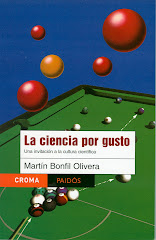Published in Milenio Diario, august 4, 2010
 Sometimes, evolution plays dirty.
Sometimes, evolution plays dirty.
Once upon a time there was a planet (ours) where, about 3.5 billion years ago, life emerged. But the first cells confronted a problem: their star emitted, apart from visible light, a respectable amount of ultraviolet rays. And this high energy radiation normally damages complex molecules, like the nucleic acids that store the genetic information. The result: mutations and death. Life was tough in those days.
In the course of evolution, millions of years later, photosynthetic organisms that released oxygen (O2) emerged. About 2.4 billion years ago, the Earth's atmosphere was became full of this gas. Part of the oxygen, high in the atmosphere, reacted to form the famous ozone layer (O3), that protects us today – although not fully– from the excess of ultraviolet radiation.
But evolution could not wait for an ozone layer. Way before that, some adaptations emerged to repair the damages that ultraviolet light caused in the cell's DNA. One of the most efficient ones was the enzyme photolyase: a protein that, activated by the visible light from the sun (hence the suffix,"photo"), reverts the damage in DNA (specifically, it breaks thymine dimers: abnormal bonds between two "steps" of of the spiral ladder of the double helix, so that when genetic information is copied into the next cellular generation, it causes mistakes: mutations).
 Photolyase was so successful that today it is found in almost every living organisms: bacteria, fungi, plants, fish, insects and some mammals, like marsupials (such as kangaroos, which carry their immature babies in their bags). But -and here comes the cruel evolutionary prank– something happened along the way. One of the branches of the tree of life suffered a mutation that eliminated the photolyase genes. As a result, humans, and all other animals with a placenta (placentals), lack photolyase, thus making us more susceptible to skin cancer. This is why we depend on sunscreens when we go to the beach or when we walk in the street in sunny days.
Photolyase was so successful that today it is found in almost every living organisms: bacteria, fungi, plants, fish, insects and some mammals, like marsupials (such as kangaroos, which carry their immature babies in their bags). But -and here comes the cruel evolutionary prank– something happened along the way. One of the branches of the tree of life suffered a mutation that eliminated the photolyase genes. As a result, humans, and all other animals with a placenta (placentals), lack photolyase, thus making us more susceptible to skin cancer. This is why we depend on sunscreens when we go to the beach or when we walk in the street in sunny days.
 Fortunately, last week, Nature magazine published the work of a Chinese researcher, Dongping Zhong, and his team, from
Fortunately, last week, Nature magazine published the work of a Chinese researcher, Dongping Zhong, and his team, from
Basic science thus gives a possible solution to an evolutionary injustice. All in the name of a good tan.
(translated by Adrián Robles Benavides) To receive Science for pleasure weekly
in your email, subscribe here!



